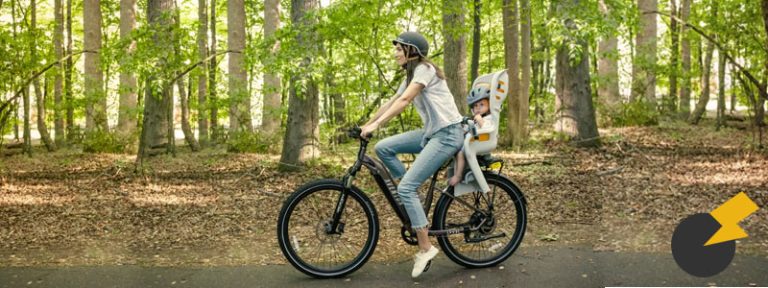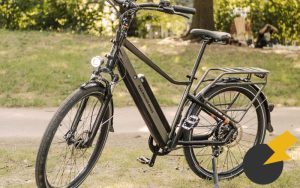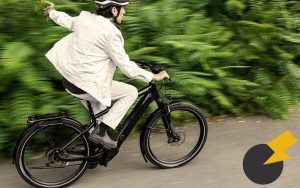Imagine this: you’re travelling along a mountain pathway with the blowing wind in your hair and the sunlight on your face. You’re not pedaling as vigorously as you normally would, but you’re still moving fast. How is this possible, you ask? It’s all with the help of the power of e-bikes!
Or imagine this: it’s Monday morning hours in Norfolk County, and you’re running late for work. You’re dreading the lengthy travel in front of you, however then you remember your trusty e-bike. With a smile on your face, you hop on and take off, leaving the stress of rush hour traffic behind.
E-bikes are like typical bicycles, but with a jazzed-up secret weapon: an electric powered motor. This indicates you can deal with high hills, headwinds, and fars away with ease, without breaking a sweat (unless, naturally, you want to). You can go farther, quicker, and experience more places than you ever could possibly on a regular bike.
However do not let the power motor unit fool you – riding an e-bike is still an adventure. You’ll feel the blowing wind charging by as you whisk along, and you’ll still get an excellent workout if you desire one. Plus, you’ll be engaging in your part for the earth by opting for a method of transportation that doesn’t rely on fossil fuels.
Regardless if you’re seeking to explore new trails, travel to the office without breaking a sweat, or just take pleasure in the freedom of two wheels, an e-bike is an electrifying and adventurous method to do it. Jump on and let the electric powered engine take you on a ride you’ll never ever forget!
Best E-Bikes in Norfolk County

As North America's largest electric bike brand, Rad Power Bikes is constantly redefining the way people and goods move with a dedicated team that designs e-bikes that can be used for anything and are affordable.
Save Big On These Limited Time Offers

Although Pedego believes in excellence and quality (a belief backed up by the manufacture of high-quality bikes), they place a much higher premium on people. With Pedego, you have a company that stands for you!

Biktrix is devoted to manufacturing electric bicycles that are affordable yet exhibit high performance. Bikes that are more convenient, more efficient and more affordable option.
What Is An E-Bike?

Types Of E-Bikes Frame Designs

E-bikes come in many sizes and shapes, with frame design being a significant factor in comfort, stability, speed, and handling. Among the most typical e-bike frame designs include step-through, step-over, mixte, folding, cruiser, and cargo frames.
Each type accommodates different riding designs and choices, making e-bikes a versatile mode of transportation. Whether you’re searching for a comfortable, kicked back trip or a sporty, performance-oriented instrument, there’s an e-bike frame style that’s best for you.
- Step-through frame: As the name suggests, this frame has a low or angled top tube, making it easy for riders to step through and mount the bike without having to swing their leg over the frame. This design is popular among riders who want a more comfortable, relaxed riding position or who have mobility issues.
- Step-over frame: This is the traditional bicycle frame design, with a high top tube that requires the rider to swing their leg over to mount the bike. This design is popular among road cyclists and riders who prefer a more aggressive, sporty riding position.
- Mixte frame: This is a variation of the step-through frame, with a partial top tube that extends diagonally from the head tube to the seat tube. This design provides additional support and stability while still allowing for easy mounting.
Folding frame: This frame is designed to be compact and portable, with features like smaller wheels and a frame that can be folded up for storage or transportation. Folding frames are a great option for commuters or riders with limited storage space. - Cruiser frame: This frame has a relaxed, comfortable riding position with wide handlebars, a plush saddle, and a laid-back geometry. This design is popular among riders who prioritize comfort and style over speed and performance.
Fat tire frame: This frame is designed for off-road riding, with extra-wide tires and a sturdy frame to support the weight of the rider and provide greater stability on loose surfaces such as sand or snow. - Cargo frame: This frame is designed to carry heavy loads, with a longer wheelbase and a sturdy frame to support the weight of cargo or gear. This design is popular among commuters and delivery riders who need to carry items with them on their bike.
These are just a several examples of e-bike frame styles, and there are several variations and combinations of these styles. Selecting the right frame design will depend on your personal riding style, needs, and choices.
Who Can Use An E-Bike?

In general, anybody who can ride a regular bike can utilize an ebike. However, the particular guidelines and policies governing using ebikes vary by country and even by state or province within countries.
In a lot of places, there are no age limitations for riding an ebike, although some jurisdictions may have specific age limits for certain types of ebikes, such as those with greater speeds or more powerful motors. Additionally, many countries require using helmets while riding an ebike, and some jurisdictions may also need a valid driver’s license or permit.
It’s important to look into and know the specific guidelines and policies in your location prior to purchasing or using an ebike. Additionally, it’s often a great idea to use protective gear like a helmet and follow safe riding practices, including following traffic laws and using appropriate signs when turning or stopping.
E-bikes can be utilized for a variety of purposes, including:
Commuting: E-bikes are an excellent choice for commuting to work or school, supplying a quicker, much easier, and more eco-friendly method to get around. They can help riders avoid traffic congestion, lower transportation costs, and improve total health and wellness.
Recreation: E-bikes are an enjoyable and exciting way to check out the outdoors, whether it’s cruising along beautiful routes or taking on challenging mountain terrain. They can help riders cover more ground and reach new places that may have been out of reach with a traditional bike.
Exercise: E-bikes can provide a low-impact, cardiovascular workout that’s easy on the joints and ideal for riders of all ages and fitness levels. They can assist riders enhance their general health and fitness, and can be utilized for both leisurely rides and more intense exercises.
Errands and shopping: E-bikes are a practical method to run errands and do shopping, offering a way to bring groceries, supplies, and other products without the need for a vehicle. They can likewise help reduce traffic congestion and improve air quality in urban locations.
Tourism: E-bikes are a popular choice for travelers who want to explore a different city or town at their own speed. They can offer a distinct and immersive method to experience local sights and attractions, without the requirement for a cars and truck or public transit.
In general, e-bikes are a versatile and practical mode of transportation that can be utilized for a vast array of functions, making them a terrific financial investment for anyone looking for an enjoyable, environmentally friendly, and effective way to navigate.
Classes Of E-Bikes In Canada
In Canada, there are three classes of ebikes, which are defined by the federal government:
Class 1 e-bikes
Class 1 e-bikes are pedal-assisted electric bicycles that can provide assistance up to a maximum speed of 32 km/h. They do not have a throttle, and the motor only operates while the rider is pedaling. Class 1 e-bikes are treated as bicycles under Canadian law and are permitted to use bike lanes and other cycling infrastructure.
Class 2 e-bikes
Class 2 e-bikes are also known as throttle-assisted e-bikes, as they can be propelled by a motor using a throttle without pedaling. They are also capable of being pedaled like a traditional bicycle. Class 2 e-bikes can provide assistance up to a maximum speed of 32 km/h. Like Class 1 e-bikes, they are treated as bicycles under Canadian law and are permitted to use bike lanes and other cycling infrastructure.
Class 3 e-bikes
Class 3 e-bikes are similar to Class 1 e-bikes in that they are pedal-assisted and can provide assistance up to a maximum speed of 32 km/h. However, Class 3 e-bikes are equipped with a motor that can provide assistance even at speeds above 32 km/h, up to a maximum speed of 45 km/h. As a result, they are not permitted on bike paths or other cycling infrastructure that is designated for bicycles only. Riders of Class 3 e-bikes must be at least 16 years of age, wear a helmet, and follow the same rules of the road as motor vehicles.
Each province or territory may have their own rules and regulations regarding e-bikes, so it’s always a good idea to check with your local authorities to ensure that you are following the most up-to-date regulations.
Electric Bike Financing In Canada

There are a few options for financing an e-bike in Norfolk County, Canada, suching as:
- Manufacturer Financing In Canada
Some e-bike producers provide financing options through partnerships with financing agencies. These financing alternatives can vary, so it is crucial to check with the specific manufacturer for information. - Bike Company Financing:
Various bike shops provide financing options for e-bikes, either through partnerships with financing business or through internal funding. These alternatives can differ, so it is essential to check with the particular purchase details. - Personal Loans
It’s likewise possible to finance an e-bike through a personal loan from a bank or other banks. These loans can be utilized to acquire an e-bike, and the terms and conditions can differ depending on the lender. - Credit Cards
Some credit cards offer financing possibilities for big purchases, consisting of e-bikes. These options can differ, so it is vital to talk to the specific credit card provider for details.
Prior to funding an e-bike, it is crucial to consider the rate of interest, payment terms, and any additional fees connected with the financing option. It’s also important to make sure that the e-bike being purchased is an excellent suitable for the rider’s requirements and budget.
FAQ
Yes, e-bikes in Norfolk County, Canada are a great option for commuting, as they are efficient, cost-effective, and environmentally-friendly. Many cities in Canada have bike lanes and other infrastructure to support commuting by e-bike, and some employers offer incentives or amenities for employees who bike to work.
Explore

As North America’s largest electric bike brand, Rad Power Bikes is constantly redefining the way people and goods move with a dedicated team that designs e-bikes that can be used for anything and are affordable.
Save Big On These Limited Time Offers
-
Oshawa woman has $3,500 e-transfer intercepted and stolen – CTV News
Source: e-bike ontario Published on 2025-07-04
-
‘Erratic’ e-dirt bike riders trigger warning from North Vancouver RCMP
Source: e-bike ontario Published on 2025-07-04
-
B.C. man riding e–bike felt heat on his leg. Moments later its battery caught fire
Source: e-bike ontario Published on 2025-07-03
-
E–bike rider seriously hurt after collision in Oshawa on Saturday afternoon: Durham police
Source: e-bike ontario Published on 2025-07-02
-
Thief strapped bike to forks of stolen backhoe in northern Ontario – Village Report
Source: e-bike ontario Published on 2025-07-02
-
July 01, 2025 Wildfire near Lytton, Abbotsford Double Homicide, Human Smuggling Arrest …
Source: e-bike ontario Published on 2025-07-01
-
July 01, 2025 Abbotsford Double Homicide, Lytton Wildfire, Human Smuggling Arrest …
Source: e-bike ontario Published on 2025-07-01
-
Bird Canada’s ‘United Way Day’ brings in several thousand dollars for Calgary and area charity
Source: e-bike ontario Published on 2025-07-01
-
Woman arrested with drugs after Anishinabek Police bike stop – CTV News
Source: e-bike ontario Published on 2025-07-01
-
Thief strapped bike to forks of stolen backhoe on Great Northern Road – SooToday.com
Source: e-bike ontario Published on 2025-07-01
-
E–bike and e-scooters no longer allowed on Mississauga MiWay Transit starting July 1
Source: e-bike ontario Published on 2025-07-01
-
E–bike rider in hospital after collision in Oshawa, Ontario – INsauga
Source: e-bike ontario Published on 2025-06-30
-
$1 from Every Bird Ride in Calgary on June 30 to Support United Way of Calgary and Area
Source: e-bike ontario Published on 2025-06-30
-
Traffic stop nets drugs, charges in northern Ont. First Nation community – CTV News
Source: e-bike ontario Published on 2025-06-30
-
$1 from Every Bird Ride in Calgary on June 30 to Support United Way of Calgary and Area
Source: e-bike ontario Published on 2025-06-30




